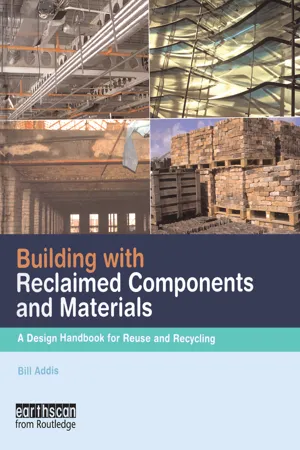![]()
1
The World of Reclamation, Reuse and Recycling
Why do it?
Very little happens in this world unless there are good reasons for it to happen. There are three main reasons why the reclaiming and recycling of goods and materials in building construction is already happening and will grow in the years to come:
1 To reduce the impact of building construction on our environment.
2 To bring benefits to a building project, for example getting planning permission or reducing costs.
3 To improve the reputation of those engaged in building construction.
For the good of the environment
The dominant reason for reusing or recycling materials and goods is to reduce our society's impact on the environment – the world we live in (Berge, 2001). The activities of the construction industry in building new buildings and refurbishing old ones, in response to society's demand for a better standard of living, are seen to have a particularly great impact on our environment. This impact can be manifested in many ways:
depletion of non-renewable natural resources – both minerals and fossil fuels;
air pollution from manufacturing processes and road transport;
degradation of the natural landscape – quarries, loss of woodland, landfill sites.
While society appreciates the improved standard of living that better buildings bring, it also sees that environmental impacts can have a detrimental effect on our overall quality of life. In recent years, this conflict has led to a growing pressure from many directions, both on and within the construction industry, to increase the reuse and recycling of goods and materials.
It is not the purpose of this book to persuade people of the need to reduce our impact on the environment, but it is worth noting that construction and demolition activities account for a large proportion of materials used and waste generated. The figures can be startling:
In the mid-1990s in Britain the construction industry used over 250 million tonnes of crushed rock and gravel as well as nearly 3.5 million tonnes of metals, around 0.5 million tonne of polymers and nearly 4 million cubic metres of timber (Kay, 2000).
In the late 1990s, around 10 million tonnes of post-industrial waste were generated by construction processes and around 30 million tonnes of materials arose from demolition (Biffa, 2002).
In Britain a decade or so ago, over 3.5 billion new bricks were used each year, while around 2.5 billion were knocked down in the demolition of buildings: of these only about 140 million were salvaged and reused – the remainder were consigned to landfill (Kay, 2000).
Perhaps the most powerful statistic is that provided by assessments of the environmental footprint of mankind's activities – the area of land that would be needed to provide all our materials and energy requirements, and to deal with the disposal of waste. London, for example, would need an area of land about the size of Spain to be fully sustainable at present levels of consumption. If every country were to have the same environmental impact as Western countries currently do, we would already need more than three Earths to ensure our long-term, sustainable survival. Clearly mankind has to do something.
Figure 1.1 The environmental footprint of mankind's activities at Western levels is already greater than three Earths
Source: US Fish and Wildlife Service
The news is not all bad, however. A survey in the UK in the late 1990s revealed that nearly 2 million tonnes of materials and products were being reclaimed and reused or recycled (Kay, 2000).
| Table 1.1 Selected reclaimed products and materials |
| Material type | Annual quantities (tonnes) |
| Architectural and ornamental antiques | 141,000 |
| Reclaimed timber beams and flooring | 242,000 |
| Clay bricks | 457,000 |
| Clay roof tiles | 316,000 |
| Clay and stone paving | 694,000 |
| Total | 1,850,000 |
Source: McGrath et al, 2000
The story in many other countries is similar. In Europe, the Netherlands, Scandinavian countries and the German-speaking nations already achieve greater reuse and recycling in the construction industry than the UK. In yet other countries, while not yet widespread, there are many examples of good reuse and recycling practices.
Metals are relatively easy to separate in demolition processes – steel and aluminium can be collected using electro-magnetic methods, and typically 90 per cent or more is reclaimed and returned to the production plants where it is mixed with virgin metal. Relatively little steel is consigned to landfill and a significant proportion – from 10 per cent to over 30 per cent according to its form – is reclaimed and reused.
Other materials are more difficult to recycle and often have to be done by hand – or rather by eye, since most separation of waste materials is based on visual examination. A number of techniques have been developed to bring some automation to the process, for example, the separation of bricks using colour-recognition and plastic bottles using shape-recognition technologies.
Despite these successes, much demolition material is sent to landfill, and the numbers of landfill sites available is diminishing while taxes are increasingly being used to discourage the disposal of materials in landfill sites. In densely populated countries such as The Netherlands and Switzerland, it is already extremely expensive.
There are thus compelling reasons for trying to reduce quantities of waste materials by increasing the recycling of materials and, whenever possible, exploiting opportunities for reusing components from buildings before ‘materials surplus to requirements’ become simply ‘waste materials'. Furthermore, shifting the balance from recycling to reclamation and reuse can reduce the reprocessing involved and hence lead to energy savings. Achieving these goals would not only reduce the growing pressure on landfill sites, it would also reduce the need to extract new raw materials from the earth. This would reduce the environmental i...







